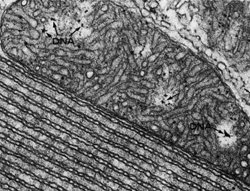Amount of Mitochondrial DNA Predicts Frailty and Mortality - 12/16/2014
Amount of Mitochondrial DNA Predicts Frailty and Mortality
Fast Facts:
- Mitochondria are structures inside cells that contain their own DNA and help generate cells’ power.
- Researchers measured mitochondrial DNA in blood samples from two large, long-term human studies.
- Frail participants had 9 percent less mitochondrial DNA than nonfrail participants.
- Those with the least mitochondrial DNA were 47 percent more likely to die during the study period than those with the most.
- Test based on mitochondrial DNA could predict at-risk individuals 10 to 15 years before symptoms of frailty begin.

New research from The Johns Hopkins University suggests that the amount
of mitochondrial DNA (mtDNA) found in peoples’ blood directly relates
to how frail they are medically. This DNA may prove to be a useful
predictor of overall risk of frailty and death from any cause 10 to 15
years before symptoms appear.
The investigators say their findings contribute to the scientific
understanding of aging and may lead to a test that could help identify
at-risk individuals whose physical fitness can be improved with drugs or
lifestyle changes. A summary of the research was published online Dec. 4 in the Journal of Molecular Medicine.
“We don’t know enough yet to say whether the relationship is one of correlation or causation,” says Dan Arking, Ph.D.,
associate professor of genetic medicine. “But either way, mitochondrial
DNA could be a very useful biomarker in the field of aging.”
Mitochondria are structures within cells often referred to as “power
houses” because they generate most of cells’ energy. Unlike other cell
structures, they contain their own DNA — separate from that enclosed in
the nucleus — in the form of two to 10 small, circular chromosomes that
code for 37 genes necessary for mitochondrial function. There are 10 to
thousands of mitochondria per cell, depending on a cell’s energy needs.
Previous research from Arking’s laboratory linked genetic differences
in mtDNA to increased frailty and reduced muscle strength in older
individuals. Medically speaking, frailty refers to a well-recognized
collection of aging symptoms that include weakness, decreased energy,
lower activity levels and weight loss. To further test this link,
Arking’s team analyzed the amount of mtDNA in blood samples collected
for two large, human studies that began in the late 1980s and tracked
individuals’ health outcomes for 10 to 20 years.
After calculating how much mtDNA each sample contained relative to the
amount of nuclear DNA, the team looked at measures of frailty and health
status gathered on the studies’ participants over time.
On average, Arking says, subjects who met the criteria for frailty had 9
percent less mtDNA than nonfrail participants. And, when grouped by
amount of mtDNA, white participants in the bottom one-fifth of the study
population were 31 percent more likely to be frail than participants in
the top one-fifth.
“It makes intuitive sense that decreased mtDNA is associated with bad health outcomes,” says Arking. “As we age, our energy reserves decrease, and we become more susceptible to all kinds of health problems and disease.”
The researchers also analyzed the age at which participants died. In
one of the studies, high levels of mtDNA corresponded to a median of 2.1
extra years of life compared to those with the lowest levels of mtDNA.
Using data from both studies, the team found that those with mtDNA
levels in the bottom one-fifth of the population were 47 percent more
likely to die of any cause during the study period than were those in
the top one-fifth. They also found that women had an average of 21
percent more mtDNA than men. According to Arking, this could play a
small role in why women live two to four years longer than men on
average.
Arking says that the research team would like to take repeated blood
samples from individuals over several years to learn if and by how much
mtDNA levels decrease over time.
What the investigators saw in the current study is that, averaged over
the population, an increase of 10 years in age corresponded to 2.5
percent less mtDNA.
The authors say they hope that mtDNA tests could detect people at risk
of frailty 10 to 15 years before they begin to experience symptoms so
that doctors can prescribe strength training or other interventions. If
low numbers of mitochondria are shown to cause or contribute to frailty,
the team can use their simple test on lab-grown cells to assess the
effectiveness of new drugs to increase the numbers of mitochondria.
Other authors of the report include Foram Ashar, Anna Moes, Amy
Matteini and Jeremy Walston of the Johns Hopkins University School of
Medicine; Ann Moore, Josef Coresh and Karen Bandeen-Roche of the Johns
Hopkins Bloomberg School of Public Health; Megan Grove and Eric
Boerwinkle of the University of Texas Health Science Center; Paulo
Chaves of Florida International University; and Anne Newman of the
University of Pittsburgh.
This work was supported by grants from the National Institute on Aging (P30-AG021334, AG023629).
For the Media
Contacts:
Catherine Kolf
443-287-2251
ckolf@jhmi.edu
Vanessa McMains
410-502-9410
vmcmain1@jhmi.edu
Shawna Williams
410-955-8236
shawna@jhmi.edu
Downloads:
The photo that accompanies this story is available for download.
We are providing this photo with the understanding that it will be used only to help illustrate the story in the corresponding news release. Please use the credit information provided. If there is anything else you need, please email us at JHMedia@jhmi.edu. Thank you.
